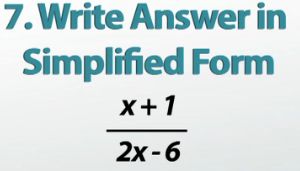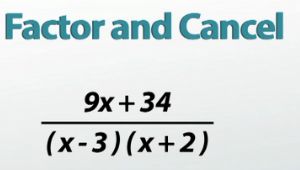Practice Adding and Subtracting Rational Expressions
After you watch the video and know the material, click HERE for the quiz.
Adding and subtracting rational expressions can feel daunting, especially when trying to find a common denominator. Let me show you the process I like to use. I think it will make adding and subtracting rational expressions more enjoyable!
Introduction
Remember back when we added and subtracted fractions? Well, a rational expression is simply a fraction with 'x's and numbers. We follow the same process for adding and subtracting rational expressions with a little twist. Now we may need to factor and FOIL to simplify the expression.
The process we will follow is:
- Factor
- Find the common denominator
- Rewrite fractions using the common denominator
- Put the entire numerator over the common denominator
- Simplify the numerator
- Factor and cancel, if possible
- Write the final answer in simplified form
 |
As we get started, let's also remember that to add or subtract fractions, we need a common denominator. Try this mnemonic to help you remember when you need a common denominator and when you don't:
Add Subtract Common Denominators, Multiply Divide None.
Auntie Sits Counting Diamonds, Mother Does Not.
Example #1
Let's look at our first example.
(x + 4)/(3x - 9) + (x- 5)/(6x- 18)
First, we need to factor.
(3x - 9) = 3 (x- 3) and (6x - 18) = 6 (x - 3)
After we replace the factored terms, our new expression looks like:
(x + 4)/3 (x - 3) + (x - 5)/6 (x - 3)
To find our common denominator, we simply write down our denominators. From the first term we have 3 (x - 3) as our denominator. We write that down for our common denominator. When we look at the second expression's denominator, 6 (x - 3), we notice that 6 = 3 * 2. So the second expression has 2 * 3 (x- 3). We already have 3 (x - 3) written, so the only piece not used is 2. We write that down multiplied by 3 (x - 3). Our common denominator will be 2 * 3 (x - 3) or 6 (x - 3).
Our next step is to multiply each piece of the expression so we have 6 (x - 3) as our new denominator. In our first fraction, we need to multiply by 2 over 2. This will give me 2 (x + 4)/2 * 3(x - 3). Looking at the second fraction, I notice I already have 6 (x - 3) in the denominator, so I can leave this one alone.
Now let's write the entire numerator over our common denominator:
2(x + 4) + (x - 5)/6(x - 3)
Let's simplify the numerator.
2(x + 4) = 2x + 8
2x + 8 + (x - 5)/6(x - 3)
Collect like terms in the numerator.
3x + 3/6(x - 3)
Factor the numerator if possible.
3x + 3 = 3 (x + 1)
The 3 over 6 reduces to 1 over 2. There isn't anything to slash or cancel, so we distribute in the numerator and denominator for our final answer:
x + 1/2x - 6
 |
Example #2
(x - 2)/(x + 5) + (x^2 + 5x + 6)/(x^2 + 8x + 15)
First, we need to factor.
x^2 + 5x + 6 = (x + 3)(x + 2)
x^2 + 8x + 15 = (x + 5)(x + 3)
After we replace the factored terms, our new expressions looks like:
(x - 2)/(x + 5) + (x + 3)(x + 2)/(x + 5)(x + 3)
To find our common denominator, we simply write down our denominators. From the first term, we have (x + 5) as our denominator. In the second term, we have (x + 5) and (x + 3). Since we already have (x + 5) written as part of our common denominator, we will just write (x + 3). So, our common denominator is (x + 5)(x + 3).
 |
Our next step is to multiply each piece of the expression, so we have (x + 5)(x + 3) as our new denominator. In the first fraction, we need to multiply by (x + 3) over (x + 3). This will give us (x - 2)(x + 3)/(x + 5)(x + 3) as our first fraction. Looking at the second fraction, I notice I already have (x + 5)(x + 3) in the denominator, so I can leave this one alone.
Now, let's write the entire numerator over our common denominator.
((x - 2)(x + 3) + (x + 3)(x + 2))/(x + 5)(x + 3)
Let's simplify the numerator by writing the numerator over our common denominator and FOIL.
(x - 2)(x + 3) = (x^2 + x - 6) and
(x + 3)(x + 2) = (x^2 + 5x + 6)
Collect like terms in the numerator.
2x^2 + 6x
Factor the numerator if possible.
2x(x + 3)
Our expression now looks like:
2x(x + 3)/(x + 5)(x + 3)
We can slash, or cancel, (x + 3) over (x + 3).
This gives us our final answer, 2x/(x + 5).
Example #3
(x^2 + 12x + 36)/(x^2 - x - 6) + (x + 1)/(3 - x)
First, we need to factor.
(x^2 + 12x + 36) = (x + 6)(x + 6)
(x^2 - x + 6) = (x - 3)(x + 2)
After we replace the factored terms, our new expressions looks like:
(x + 6)(x + 6)/(x - 3)(x + 2)) + (x + 1)/(3 - x)
To find our common denominator, we simply write down our denominators. From the first term, we have (x - 3)(x + 2) as our denominator. In the second term, we have (3 - x). I could write (3 - x) as part of the common denominator, but I know that -1 * (x - 3) = (3 - x). So, now it will match with the denominator (x - 3).
Now, our expression looks like:
(x + 6)(x + 6)/(x - 3)(x + 2)) + (x + 1)/-1(x - 3
And that -1? It can be put into the numerator. Remember, 1/-1 = -1/1 = -1. It doesn't matter where I put the -1 in the fraction as long as I have a +1 to match it.
So, our common denominator is (x - 3)(x + 2).
In the first fraction, I already have the common denominator (x - 3)(x + 2), so I leave that one alone. In the second fraction, I need to multiply by (x + 2) over (x + 2). This gives us the common denominator of (x - 3)(x + 2).
Our expression now looks like:
(x + 6)(x + 6)/(x - 3)(x + 2) + (-1)(x + 1)(x + 2)/(x - 3)(x + 2)
Let's simplify the numerator by writing the numerator over our common denominator and using FOIL, which is First Outside Inside Last.
(x + 6)(x + 6) = x^2 + 12x + 36
and
(-1)(x + 1)(x + 2) = (-1)(x^2 + 3x + 2) = -x^2 - 3x- 2
Collect like terms in the numerator. Our expression now looks like:
(9x + 34)/(x - 3)(x + 2)
The numerator doesn't factor, so our last step is to FOIL the denominator.
Our final answer is (9x + 34)/(x^2 - x - 6).
 |
Lesson Summary
The process we follow is:
- Factor
- Find the common denominator
- Rewrite fractions using the common denominator
- Put the entire numerator over the common denominator
- Simplify the numerator
- Factor and cancel, if possible
- Write the final answer in simplified form
Simplifying rational expressions may feel like a daunting process right now, but with practice, you will get better. One tip from me to you: If you don't have the right answer the first time, don't erase the entire expression. Start from the beginning of your work, and look for little mistakes. Many of my students have the right idea, just a misplaced sign or a factoring error.